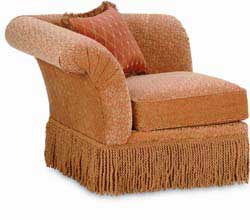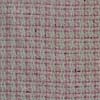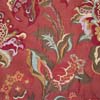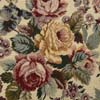
The best place to start is to determine where your upholstered pieces will be used in the home. Sofas, chairs, and ottomans receiving only moderate amounts of wear will do fine with a less durable fabrics; those in high traffic areas or pieces subjected to daily heavy wear need to be covered in tough, durable, tightly woven fabrics.
When purchasing an upholstered piece or upholstery fabric, be aware that the higher the thread count, the more tightly woven the fabric is, and the better it will wear. Thread count refers to the number of threads per square inch of fabric; just like you see when you buy linens for the bed.
Today's consumer is looking for "natural fabrics" and lots of textural interest. Cotton is quite popular because like any natural fiber, it's inherently strong and comfortable.

Natural Fabrics:
Linen: Linen is best suited for formal living rooms or adult areas because it soils and wrinkles easily. Linen is a delicate fabric and does not withstand heavy wear; however, linen does resist pilling and fading. Soiled linen upholstery must be professionally cleaned to avoid shrinking.
Leather: This tough material can be gently vacuumed, wiped with a damp cloth and cleaned with leather conditioner or saddle soap.
Cotton: This natural fiber provides good resistance to wear, fading, and pilling. It is less resistant to soil, wrinkling, and fire. Surface treatments and blending with other fibers often atone for these weaknesses. Durability and use depend on the weave and finish. Damask weaves are formal; canvas (duck and sailcloth) is more casual and more durable.
Wool: Sturdy and durable, wool and wool blends offer good resistance to pilling, fading, wrinkling, and soil. Generally, wool is blended with a synthetic fiber to make it easier to clean and to reduce the possibility of felting the fibers (causing them to bond together until they resemble felt). Blends can be spot-cleaned when necessary.
Cotton Blend: Depending on the weave, cotton blends can be sturdy, family-friendly fabrics. A stain-resistant finish should be applied for everyday use.
Vinyl: Easy-care and less expensive than leather, vinyl is ideal for busy family living and dining rooms. Durability depends on quality.
Silk: This delicate fabric is only suitable for adult areas, such as formal living rooms. It must be professionally cleaned if soiled.
Synthetic Fabrics:
Acetate: Developed as imitation silk, acetate can withstand mildew, pilling, and shrinking. However, it offers only fair resistance to soil and tends to wear, wrinkle, and fade in the sun. It's not a good choice for furniture that will get tough everyday use.
Acrylic: This synthetic fiber was developed as imitation wool. It resists wear, wrinkling, soiling, and fading. Low-quality acrylic may pill excessively in areas that receive high degrees of abrasion. High-quality acrylics are manufactured to pill significantly less.
Nylon: Rarely used alone, nylon is usually blended with other fibers to make it one of the strongest upholstery fabrics. Nylon is very resilient; in a blend, it helps eliminate the crushing of napped fabrics such as velvet. It doesn't readily soil or wrinkle, but it does tend to fade and pill.
Olefin: This is a good choice for furniture that will receive heavy wear; however, it lacks the pliability and movement that natural fibers offer.
Polyester: Rarely used alone in upholstery, polyester is blended with other fibers to add wrinkle resistance, eliminate crushing of napped fabrics, and reduce fading. When blended with wool, polyester can cause pilling.
Rayon: Developed as an imitation silk, linen, and cotton, rayon is durable, yet wrinkles easily. Recent developments have made high-quality rayon very practical.
Fabric Definitions:
Ever entered a "fabric bee," a fabric definition bee that is? See how you
do in defining the following fabrics:
Boucle: Identified by its curled or looped surface, this material
is heavier than many other upholstery fabrics.

Chenille: French for "caterpillar," chenille has a thick, soft pile
and is one of today's most popular fabrics. It was originally used in the
1800's to block drafts at doors and windows.

Damask: A sophisticated, floral-patterned fabric, damask has reversed
colors on opposing sides.

Jacquard: An intricate fabric that features a variegated weave or
multi-color pattern.

Tapestry: This heavy, flat-woven fabric features elaborate designs
appropriate for various uses throughout the home.

Toile de Jouy: Dating back to 18th century France, this cotton print
(typically in one color on a natural ground) depicts pictorial scenes.
